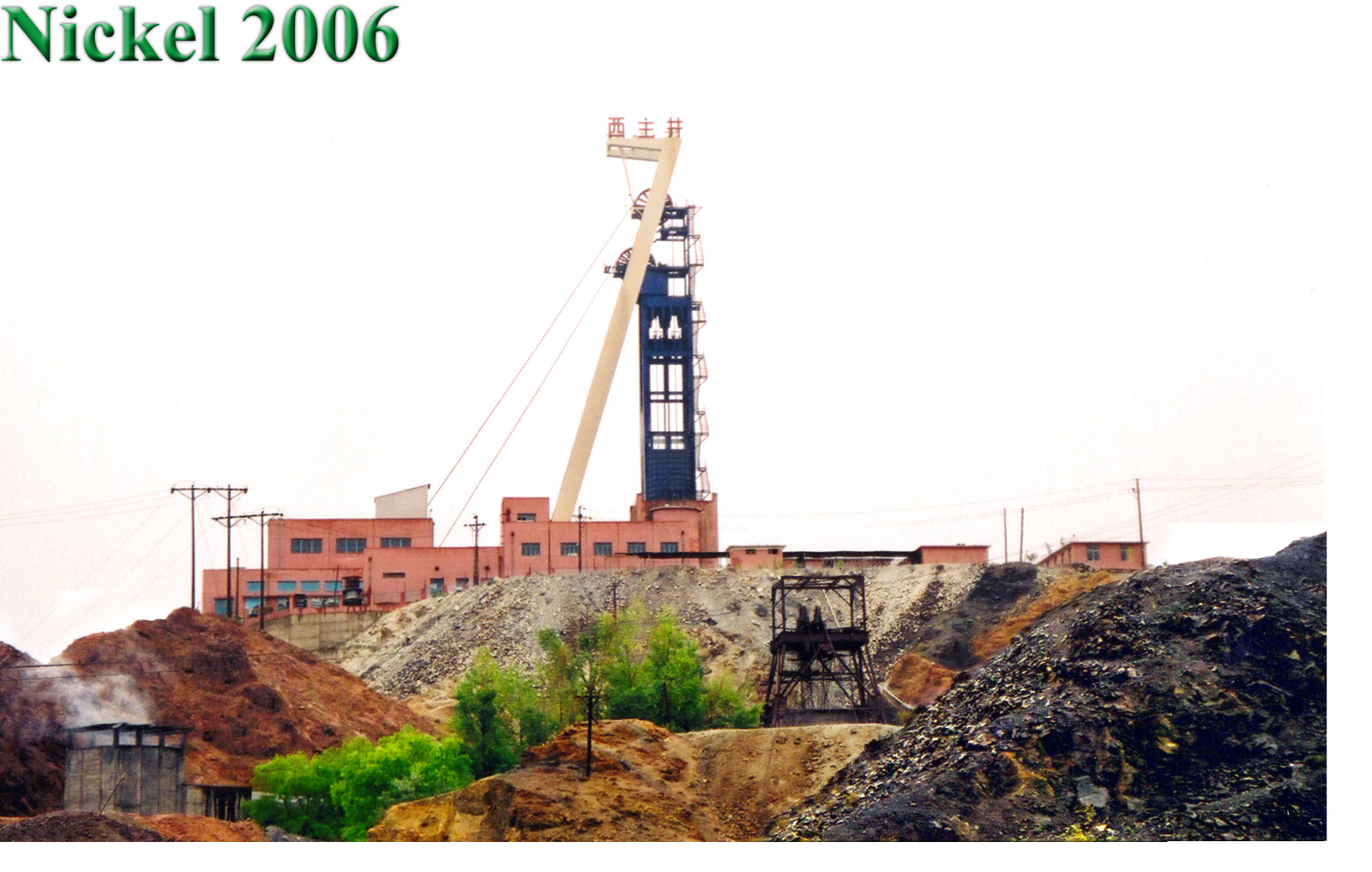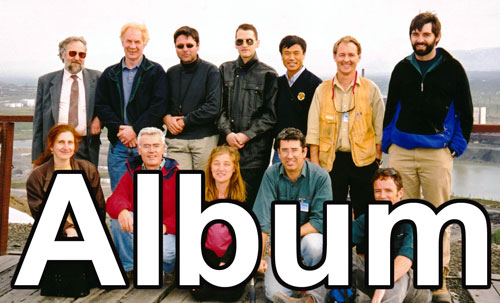
Porter GeoConsultancy continued our International Study Tour series of professional development courses by visiting a representative selection of the most significant magmatic nickel sulphide deposits in the northern hemisphere.

The visits were supported by both workshops run by renowned experts and by field workshops outlining their occurrence and setting.

The tour started in Duluth, Minnesota, USA on the evening of Sunday 9 July, and visited deposits in the United States, Canada, Russia and China, ending in Beijing, China on the evening of Thursday 27 July 2006.

Participants had the option of taking either the full tour -or- any block of 4 or more days up to the the full tour, as suited their availability and interest.

The first of the two day long workshops was in Sudbury, Canada, and concentrated on North American deposits. It was led by Professor Mike Lesher from Laurentian University in Sudbury. The second was conducted in Moscow, Russia, led by Prof. Tony Naldrett who provided insights into the setting and styles of magmatic Ni-Cu-PGE mineralisation in Eurasia.

 Photo Album - who went & what they saw. Photo Album - who went & what they saw.

The countries/regions and deposits visited were as follows:

United States

 Duluth Complex - NorthMet Project, Cu-Ni-PGE deposit, Minnesota, USA. The Duluth Complex occurs towards the northern end of the 1500 km long, horseshoe-shaped, 1.1 Ga Mid Continental Rift zone. The NorthMet deposit is hosted by the Partridge River Troctolite Series which comprises an Anorthositic, Troctolitic and late stage Felsic-Series. At Northmet, 1 to 2% disseminated/interstitial sulphides, mainly pyrrhotite, chalcopyrite, cubanite and minor pentlandite, occur throughout the troctolitic sequence, but are generally more prevalent near the basal contact with underlying meta-sedimentary rocks ..... Monday 10 July, 2006. Duluth Complex - NorthMet Project, Cu-Ni-PGE deposit, Minnesota, USA. The Duluth Complex occurs towards the northern end of the 1500 km long, horseshoe-shaped, 1.1 Ga Mid Continental Rift zone. The NorthMet deposit is hosted by the Partridge River Troctolite Series which comprises an Anorthositic, Troctolitic and late stage Felsic-Series. At Northmet, 1 to 2% disseminated/interstitial sulphides, mainly pyrrhotite, chalcopyrite, cubanite and minor pentlandite, occur throughout the troctolitic sequence, but are generally more prevalent near the basal contact with underlying meta-sedimentary rocks ..... Monday 10 July, 2006.

Canada

 North American Workshop at Laurentian University, Sudbury, Ontario. A one day workshop was led by Prof. Mike Lesher of the Mineral Exploration Research Centre, Department of Earth Sciences at that university. This workshop provided: i). an overview of the principles of the formation of magmatic Ni-Cu-PGE deposits; ii). the geological, metallogenic and tectonic setting and descriptions of key magmatic Ni-Cu-PGE in Canada, particularly Raglan and Thompson; and iii). an overview and context setting of the Sudbury Igneous Complex and ore deposits, as a context to the North American segment of the tour and the Sudbury vists ..... Wednesday 12 July, 2006. North American Workshop at Laurentian University, Sudbury, Ontario. A one day workshop was led by Prof. Mike Lesher of the Mineral Exploration Research Centre, Department of Earth Sciences at that university. This workshop provided: i). an overview of the principles of the formation of magmatic Ni-Cu-PGE deposits; ii). the geological, metallogenic and tectonic setting and descriptions of key magmatic Ni-Cu-PGE in Canada, particularly Raglan and Thompson; and iii). an overview and context setting of the Sudbury Igneous Complex and ore deposits, as a context to the North American segment of the tour and the Sudbury vists ..... Wednesday 12 July, 2006.

 Sudbury Ni-Cu-PGE deposits Sudbury Ni-Cu-PGE deposits, located within the basal layer of the roughly oval shaped 65 x 25 km, 1.85 Ga, Sudbury Igneous Complex in south-western Ontario, comprising i). basal contact type massive sulphides; ii). more Cu rich stockworks ore in the Sudbury Breccia of the footwall deposits; or iii). lenticular zones of sulphide blebs associated with Offset Dykes of quartz-diorite. The day and a half program included mine visits, drill core displays and field workshops to demonstrate the different ore styles and parts of the Sudbury Igneous Complex. Mines visited on the Sudbury North Range included the Falconbridge Craig and Fraser and Inco Coleman operations, followed by a North Range Traverse hosted by Falconbridge on the first day. The second day took in the Inco Creighton mine in the South Range, and the geology of that range ..... Thursday 13 and am Friday 14 July, 2006.

 Voiseys Bay Voiseys Bay Ni-Cu-Co deposits, near the eastern coast of Labrador, some 1500 km to the NE of Montreal. Mineralisation is hosted by two east plunging intrusions, the lower Reid Brook and the upper Eastern Deeps intrusions, and a steeply dipping dyke, the Feeder Sheet which links the two. All three are part of a 1334 Ma troctolite sheet belonging to the extensive Nain Plutonic Suite. Economic mineralisation, mainly massive pyrrhotite-pentlandite, with irregular chalcopyrite and cubanite, occurs both within the wider sections of the Feeder Sheet and at the base of the Eastern Deeps intrusive, from where it grades up into disseminated sulphides. Voiseys Bay was covered by a detailed presentation and study of drill core held in Sudbury ..... pm Friday 14 July, 2006.
 Russia
Russia

 Eurasian Workshop Eurasian Workshop in Moscow. A full day workshop was led by Prof. Tony Naldrett who provided insights into the setting and styles of magmatic Ni-Cu-PGE mineralisation found in Eurasia. It covered: i). the general principles of the setting, formation, geology, geochemistry and mineralogy of magmatic Ni-Cu-PGE deposits; ii). the application of the concepts and characteristics outlined above to exploration; iii). an overview of the geology, mineralogy and geometry of the key magmatic Ni-Cu-PGE deposits of Eurasia, particularly Noril'sk-Talnakh and Jinchuan; iv). a detailed description of the Pechenga Ni-Cu deposits ( see below) ..... Wednesday 12 July, 2006.

 Pechenga Pechenga presentation. For organisational reasons, it was not practical to secure a visit to the Pechenga district. However, a detailed, illustrated presentation on geology and deposits was delivered in Moscow as part of the Eurasian Workshop by an expert geologist, Dr. Valery F. Smolkin, who worked on the deposit for many years. The Pechanga Ni-Cu deposits, with associated Co-Pt-Pd, are located on the Kola Peninsula of north-western Russia, hosted within the Pechenga Greenstone Belt, part of the larger 2.0 to 1.97 Ma, 1000 km long Palaeoproterozoic North Transfennoscandian greenstone belt, which is sandwiched between blocks of Archaean crust. The greenstone belt contains numerous massive and disseminated sulphide ore deposits hosted within differentiated sills with composition grading upwards from wehrilte through pyroxenite to gabbro, with less common non-differentiated ultramafic or gabbro intrusions ..... Wednesday 12 July, 2006.

 Noril'sk and Talnakh Noril'sk and Talnakh Ni-Cu-PGE deposits, northern Siberia, east of the Urals and ~450 km SE of the Yenisei River mouth into the Arctic Ocean. The Noril'sk and Talnakh clusters of deposits are 35 km apart and are developed near the north-western margin of the Siberian Platform. The deposits are found as disseminated and massive sulphides associated with a suite of differentiated gabbro-dolerite sills. These sills and associated dykes represent part of the feeder system to the up to 3500 m thick, and >2.5 million km 2 Permo-Triassic Siberian Trap basalts. They were emplaced within and adjacent to the continental scale, NNE trending Noril'sk-Kharayelakh fault. While the sulphides are dominantly lower grade and disseminated within the sill complex at Noril'sk, at Talnakh they also include major higher grade and massive accumulations, locally up to 60 m thick, found principally on the lower contact of the mineralised sills, both within the underlying, thick, Palaeozoic, evaporite-rich shelf sedimentary sequence, and to a lesser degree the sill. The massive sulphides are sometimes separated from the sill by several metres of barren sediment or cupriferous mineralisation. At both Noril'sk and Talnakh, mineralisation also appears to be spatially related to the intersection of both the Noril'sk-Kharayelakh fault and the mineralised mafic sills/dykes, with a thick sequence of Late Carboniferous to Permian sulphide bearing coal measure which have been thermally metamorphosed to anthracite and graphite ..... Tuesday 18 to Thursday 20 July, 2006.

China

 Jinchuan Ni-Cu-Co-PGE deposit, Gansu, northern China. The deposit is located within the Alasahan Massif, an east-west elongated terrane that forms the westernmost extension of the North China Craton. Mineralisation is hosted within the 6.5 km long, ~0.83 Ga, Neoproterozoic Jinchuan ultramafic intrusion, emplaced as a composite sill-like body into a Palaeoproterozoic suite of gneisses, migmatites, marbles and amphibolites, below an active intracratonic rift. It was injected into three interconnected sub-chambers, each containing a separate orebody. In detail, it comprises two intrusive phases with different characteristics, the Western Intrusion in the western sub-chamber, and the Eastern Intrusion in the other two. Both essentially comprises an olivine-orthopyroxene-chromite cumulate, with interstitial orthopyroxene, clinopyroxene, plagioclase and phlogopite, and is ~80% composed of lherzolite, with an outer rim of olivine pyroxenite and cores of mineralised dunite. Mineralisation occurs as disseminated and net-textured sulphides, predominantly within the dunite, with lesser, PGE rich lenses, late massive sulphide accumulations, small copper rich pods and limited mineralised diopside skarn in wall rock marbles. The principal ore minerals are pyrrhotite (the dominant sulphide), pentlandite, chalcopyrite, cubanite, mackinawite and pyrite, with a variety of platinum group minerals and minor gold ..... Tuesday 25 to Wednesday 26 July, 2006. Jinchuan Ni-Cu-Co-PGE deposit, Gansu, northern China. The deposit is located within the Alasahan Massif, an east-west elongated terrane that forms the westernmost extension of the North China Craton. Mineralisation is hosted within the 6.5 km long, ~0.83 Ga, Neoproterozoic Jinchuan ultramafic intrusion, emplaced as a composite sill-like body into a Palaeoproterozoic suite of gneisses, migmatites, marbles and amphibolites, below an active intracratonic rift. It was injected into three interconnected sub-chambers, each containing a separate orebody. In detail, it comprises two intrusive phases with different characteristics, the Western Intrusion in the western sub-chamber, and the Eastern Intrusion in the other two. Both essentially comprises an olivine-orthopyroxene-chromite cumulate, with interstitial orthopyroxene, clinopyroxene, plagioclase and phlogopite, and is ~80% composed of lherzolite, with an outer rim of olivine pyroxenite and cores of mineralised dunite. Mineralisation occurs as disseminated and net-textured sulphides, predominantly within the dunite, with lesser, PGE rich lenses, late massive sulphide accumulations, small copper rich pods and limited mineralised diopside skarn in wall rock marbles. The principal ore minerals are pyrrhotite (the dominant sulphide), pentlandite, chalcopyrite, cubanite, mackinawite and pyrite, with a variety of platinum group minerals and minor gold ..... Tuesday 25 to Wednesday 26 July, 2006.

The tour was organised, managed and escorted by Mike Porter of Porter GeoConsultancy Pty Limited. See the photo album, linked above, for more detail.

|













